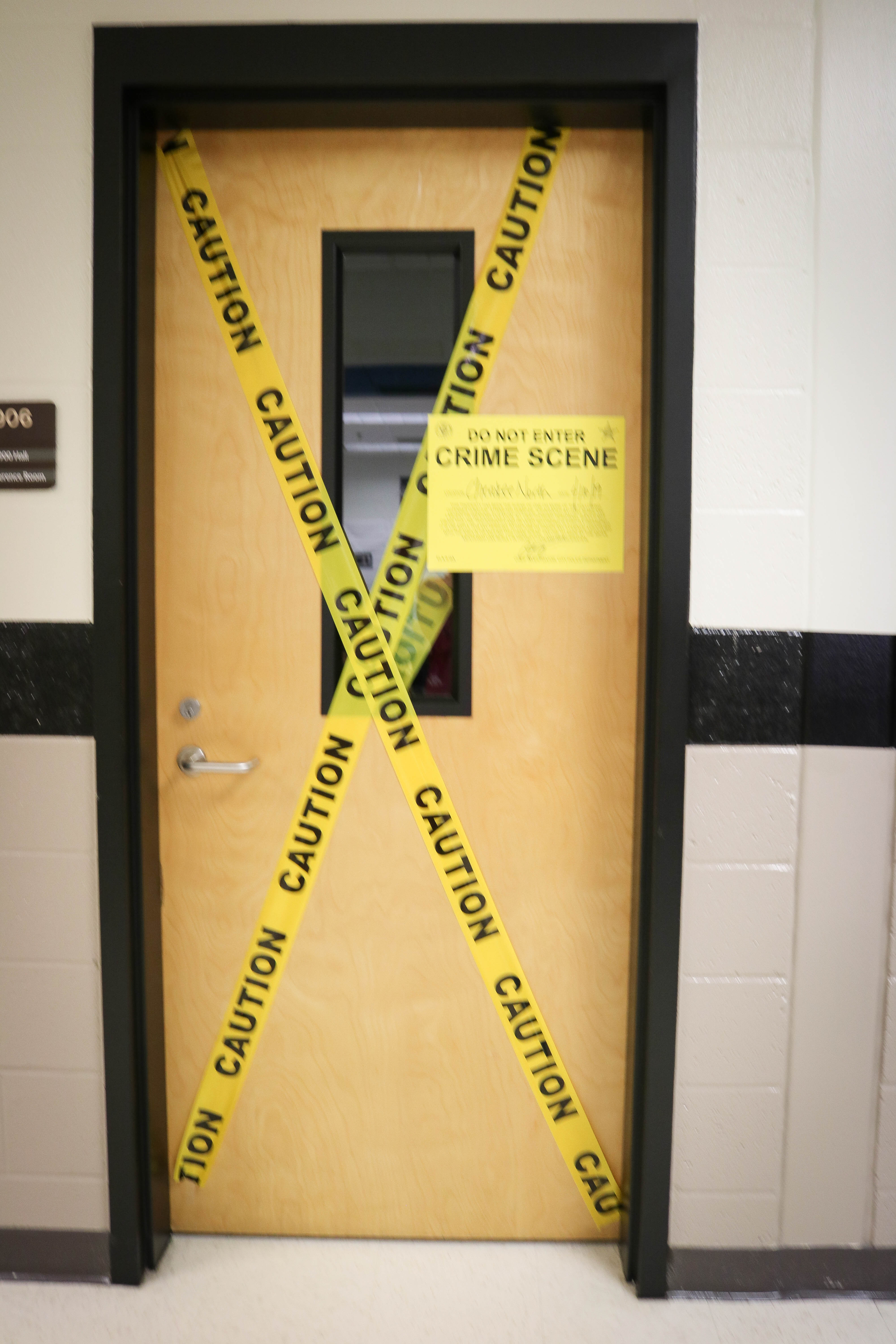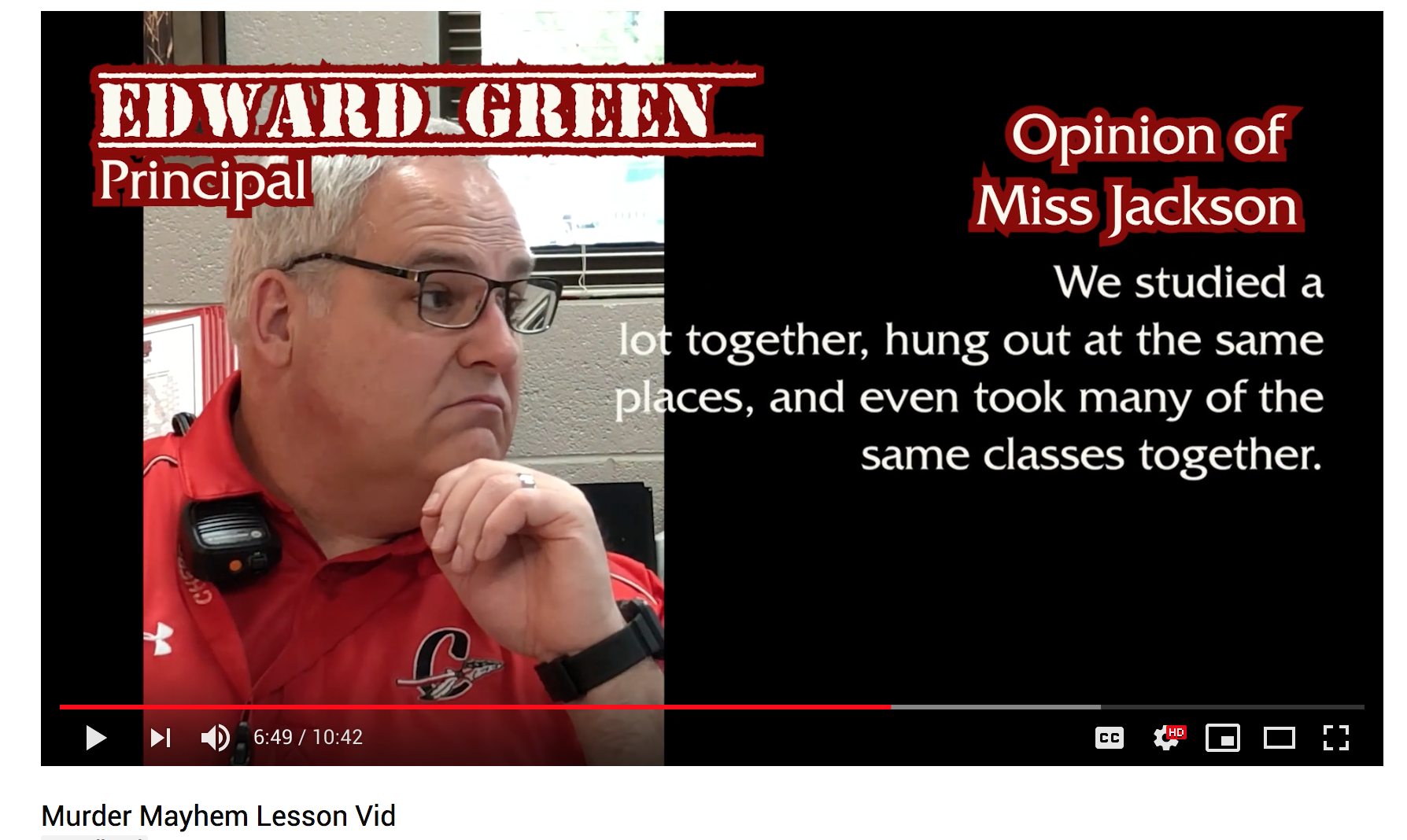Countless students seemed caught off-guard as they passed this door Thursday on the 900 Hall at Cherokee North–many bravely taking a peek in.

All of this was to the great amusement of Ms. Teasley (Ms. T) across the hall who set the whole thing up for a lesson to review for the 9th ELA End of Course Assessment the first week in May. Also amused was Mr. Williams next door, who played a suspect on video for the lesson, and stayed in character literally the entire school day.
To the several students who asked him about it, he responded, “I…I’m not allowed to talk about it.”
Some were definitely fooled. The room was a fairly empty classroom designated for conferences, but it had been temporarily converted into a crime scene. The Newspaper Club was crucial in collecting “suspect testimonies” that would be used.

The idea of conducting classroom murder mysteries is not uncommon in teaching reading and listening comprehension, inferencing, and finding and using text evidence to prove a claim–such as a claim of a suspect’s guilt.
However, unlike most classroom murder mysteries, several staff members got involved, including three administrators, teachers, counselor, support staff, and even the school’s resource officer who was a former crime scene detective.
It all started only two days before on a rainy Tuesday after school when several members of the newspaper club flipped through pages of scripts, divided up the stories, and scurried all around both campuses begging for willing volunteers, who had already stayed late, to read a script on phone cameras having been given no prior notice for this last-minute lesson idea. Several parts were needed, and many happily obliged. Hali Coombs, a writer for the newspaper, played a role herself utilizing her prior acting experience.
These actors and actresses did an outstanding job. The suspect reports were compiled into a video that would be played on a projector screen next to the crime scene as students could read along on printed copies.

Thursday, students in the 9th Grade English classroom were told by “Detective Chief Superintendent Teasley” that her detectives all got sick, and they, her rookies, needed to report on duty today to help cover this gruesome crime that occurred at a class reunion the previous night. Every protocol had to be followed, including signing in to the scene. No one quite knew what to expect when they walked in to the conference room.
Yes, they really had to sign in, and in one class, CHS Resource Officer, Officer Rivas, who once was a actual crime scene detective for nine years, set the tone enforcing protocol was followed properly by belting orders ensuring no silly rookie behavior.
He also spent a couple minutes sharing a little bit about his experiences, and how important it is that we are all very aware of our surroundings should our witness testimonies one day be of need.
Students had to then purvey the crime scene, taking notes. Police radio chatter played over speakers and beacon lights, caution tape, and “crime scene” and “keep out” signs framed the scene.
Students took the idea very seriously, quietly and respectfully circling the scene, and afterwards, they sat down to take notes on their pre-printed evidence pages and crime report guides. The video took off the serious edge with hysterical performances of the actors. Students shouted that some suspects must be lying, and followed the stories intently. Many just wanted one assistant principal or another to be guilty.
The lesson will reconvene the following day with recaps, suspect analysis, and creating a statement to use in court. Each student will prepare an either written or recorded video report explaining how the evidence they found supports their point.
When asked about the reason for this lesson, Ms. T said that she constantly kept giving the metaphor of a trial attorney or crime scene detective when writing evidence-based responses, and just decided it would be better to make that metaphor more relatable.
Good job, rookies, and great work to the team that pulled this fun lesson together.





















